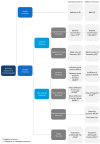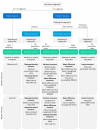Summary Measures of Health Inequality: A Review of Existing Measures and Their Application
- PMID: 35329383
- PMCID: PMC8992138
- DOI: 10.3390/ijerph19063697
Summary Measures of Health Inequality: A Review of Existing Measures and Their Application
Erratum in
-
Correction: Schlotheuber, A.; Hosseinpoor, A.R. Summary Measures of Health Inequality: A Review of Existing Measures and Their Application. Int. J. Environ. Res. Public Health 2022, 19, 3697.Int J Environ Res Public Health. 2022 Jun 7;19(12):6969. doi: 10.3390/ijerph19126969. Int J Environ Res Public Health. 2022. PMID: 35742801 Free PMC article.
Abstract
Measuring and monitoring health inequalities is key to achieving health equity. While disaggregated data are commonly used to assess differences in health between different population subgroups, summary measures of health inequality also play a vital role in monitoring health inequalities. Building on disaggregated data, they quantify the level of inequality in a single number and are useful to compare inequality over time and across different health indicators, programmes and settings. We provide a comprehensive overview of existing summary measures of health inequality, including their definition, calculation, interpretation and application. The use of these measures is illustrated based on an example from the WHO's Health Equity Monitor database using the WHO's Health Equity Assessment Toolkit (HEAT) software. We discuss the strengths and limitations of different measures and provide guidance for selecting suitable summary measures for analysing health inequalities and communicating results. Summary measures of health inequality should form an integral part of health inequality monitoring to inform equity-oriented policies and programmes.
Keywords: health equity; health inequality; measurement; monitoring; summary measures.
Conflict of interest statement
The authors declare no conflict of interest. The authors are staff members of the World Health Organization. The authors alone are responsible for the views expressed in this article and they do not necessarily represent the decisions, policy or views of the World Health Organization.
Figures






Similar articles
-
Health Equity Assessment Toolkit (HEAT): software for exploring and comparing health inequalities in countries.BMC Med Res Methodol. 2016 Oct 19;16(1):141. doi: 10.1186/s12874-016-0229-9. BMC Med Res Methodol. 2016. PMID: 27760520 Free PMC article.
-
Health Equity Assessment Toolkit (HEAT and HEAT Plus): exploring inequalities in the COVID-19 pandemic era.Int J Equity Health. 2022 Dec 5;21(Suppl 3):172. doi: 10.1186/s12939-022-01765-7. Int J Equity Health. 2022. PMID: 36471346 Free PMC article.
-
Health Equity Assessment Toolkit Plus (HEAT Plus): software for exploring and comparing health inequalities using uploaded datasets.Glob Health Action. 2018;11(sup1):1440783. doi: 10.1080/16549716.2018.1440783. Glob Health Action. 2018. PMID: 29974823 Free PMC article.
-
Strengthening and expanding health inequality monitoring for the advancement of health equity: a review of WHO resources and contributions.Int J Equity Health. 2023 Mar 17;22(1):49. doi: 10.1186/s12939-022-01811-4. Int J Equity Health. 2023. PMID: 36932363 Free PMC article. Review.
-
Equity-oriented monitoring in the context of universal health coverage.PLoS Med. 2014 Sep 22;11(9):e1001727. doi: 10.1371/journal.pmed.1001727. eCollection 2014 Sep. PLoS Med. 2014. PMID: 25243463 Free PMC article. Review.
Cited by
-
Socioeconomic and geographical inequalities in delivery by cesarean section among women in Bangladesh, 2004-2017.BMC Pregnancy Childbirth. 2024 Feb 13;24(1):131. doi: 10.1186/s12884-024-06327-z. BMC Pregnancy Childbirth. 2024. PMID: 38350916 Free PMC article.
-
Socioeconomic and geographical inequalities in using skilled birth attendants during delivery in Bangladesh over two decades.BMC Pregnancy Childbirth. 2023 Jun 9;23(1):430. doi: 10.1186/s12884-023-05754-8. BMC Pregnancy Childbirth. 2023. PMID: 37296394 Free PMC article.
-
Utilization of Health Care Services and Accessibility Challenges among Adults Aged 50+ before and after Austerity Measures across 27 European Countries: Secular Trends in the SHARE Study from 2004/05 to 2019/20.Healthcare (Basel). 2024 Apr 30;12(9):928. doi: 10.3390/healthcare12090928. Healthcare (Basel). 2024. PMID: 38727485 Free PMC article.
-
Inequalities of Infant Mortality in Ethiopia.Int J Environ Res Public Health. 2023 Jun 6;20(12):6068. doi: 10.3390/ijerph20126068. Int J Environ Res Public Health. 2023. PMID: 37372655 Free PMC article.
-
Global Burden, Trends, and Inequalities of Clostridioides difficile Infections from 1990 to 2021 and Projections to 2040: A Systematic Analysis.Antibiotics (Basel). 2025 Jun 27;14(7):652. doi: 10.3390/antibiotics14070652. Antibiotics (Basel). 2025. PMID: 40723955 Free PMC article.
References
-
- World Health Organization Health Equity. [(accessed on 24 January 2022)]. Available online: https://www.who.int/health-topics/health-equity.
-
- United Nations Transforming Our World: The 2030 Agenda for Sustainable Development. [(accessed on 24 January 2022)]. Available online: https://sdgs.un.org/2030agenda.
-
- United Nations Sustainable Development Goals. [(accessed on 19 January 2022)]. Available online: https://sdgs.un.org/goals.
Publication types
MeSH terms
Grants and funding
LinkOut - more resources
Full Text Sources
Medical

